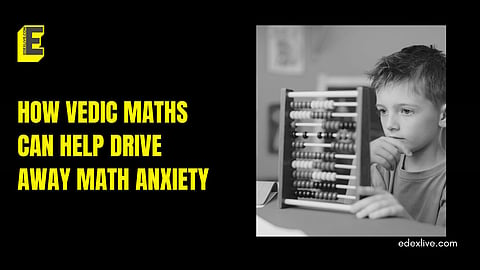How Vedic Maths can help drive away math anxiety
How does math anxiety affect students?
Multiple studies suggest that 25% to 80% of students suffer from Maths anxiety to such a crippling degree that it can extend well into adulthood. We also know that the fear of Math is what often prohibits adults from taking charge of their finances.
Studies have shown that financially literate and aware adults can save-invest in a way that doubles their lifetime earnings. So fear of Math actually has a much more corrosive and far-reaching impact than just marksheets in school and university.
How does one tackle this?
Math anxiety can be changed if we find ways to teach students Math in a way that helps them see the subject as a building block of life rather than something they need to somehow manage to stay ahead of just for the sake of exams.
I believe Vedic Maths does this beautifully because it demystifies the subject, makes it simple and understandable, and once they "get" it, students can do even complex calculations 8-10 times faster.
Unlike traditional Math, which only becomes more complicated and therefore demoralising for the average kid, in our experience, once kids start seeing how easily they can be successful at Math with the formulae of Vedic Math, they actually start getting excited and interested in the subject, instead of waiting for the time they can drop it from their curriculum!
How do you make math concepts easy and fun for children.
It is my belief that Generation Alpha is a take-charge generation. They don't want to be passive receives of decisions about what, how, and when they will learn. I think this might be because this is the first truly digitally native generation, and was born into the informational access that was made possible by sophisticated tools and technologies that could be afforded by the masses.
And because of this access, the very meaning of 'learning' differs for this generation. Once upon a time, learning used to be linear and one-way, with students consuming learning content.
What does learning involve?
Now, for learning to be successful, it needs to be understood. And for understanding to be possible, students need to be able to engage and communicate with their learning material. Which, by definition, means learning needs to be two-way.
All of which is to say that there is no one-size-fits-all approach that can be used to make concepts easy and fun for children, because one student's easy is another's complicated.
So the only way to actually do this is by ensuring that children are delivered learning material that forces them to think and questions what they know, while factoring in their comprehension levels, pace of learning, linguistic nuances, and inherent interests so that the learning is deep and ever-lasting and not temporary.
What is the future of vedic math in the current educational setup of India?
I expect it to gain popularity and momentum in the coming years, as governments and institutions realise that for Indian students to truly realise their potential in the age of Artifical Intelligence (AI), the way they are taught even traditional subjects needs to radically change. We are already seeing that many states — Gujarat, Assam, Haryana, MP, UP, and others — either already have Vedic Maths in their syllabus or are preparing to introduce it.
There is growing support for Vedic Math to formally become a part of middle school syllabus under the Natioanl Education Policy (NEP) in upcoming academic years. Exciting changes are afoot and I believe it is only a matter of time before we see radical changes in the way we do education in India.



